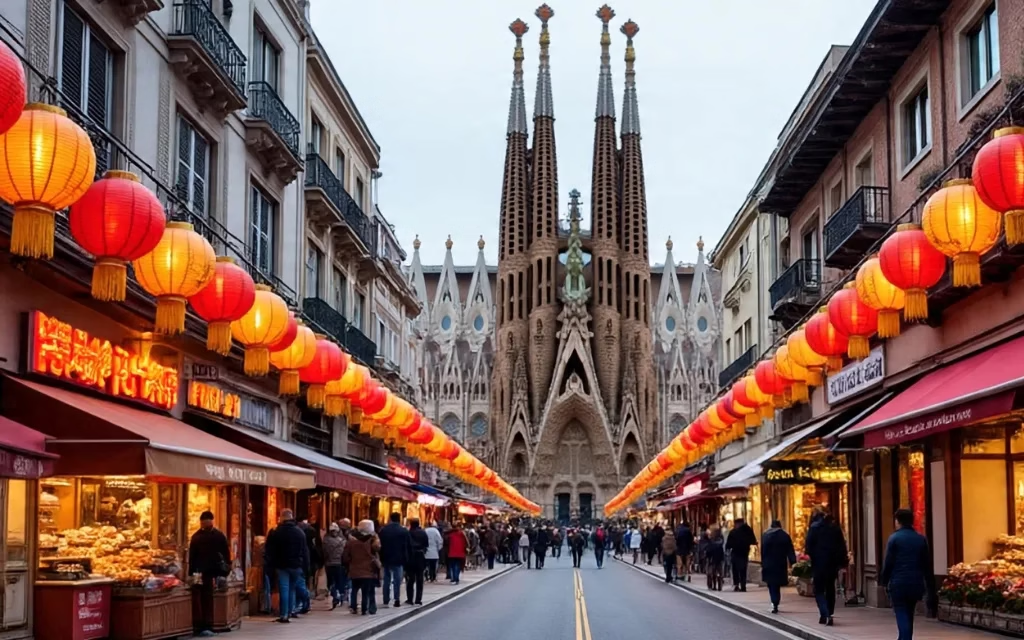Explore the fascinating journey between Daegu – Barcelona with this in-depth guide. From travel tips and cultural insights to must-see attractions and food highlights, discover everything you need to know. Whether you’re planning a visit or curious about both cities, this article covers it all in a simple, informative way, optimized for your travel needs and search convenience.
10 Essential Things to Know About Daegu – Barcelona Travel and Connection
The connection between Daegu – Barcelona is more than just a flight across continents. It’s a journey between two cities steeped in culture, history, and vibrancy. Whether you are planning a business trip, a student exchange, or a cultural vacation, understanding the details of traveling from Daegu – Barcelona is key to making your experience smooth and memorable.
Daegu – Barcelona Travel Overview
Flying between Daegu – Barcelona usually requires at least one layover, often in cities like Seoul, Doha, Istanbul, or Dubai. The average travel time ranges between 16 to 22 hours depending on the chosen airline and layover duration. While Daegu International Airport is smaller than Seoul’s Incheon, it offers convenient domestic connections. On the Barcelona side, El Prat Airport welcomes global travelers with modern facilities and easy transport links to the city center.
Major airlines servicing the Daegu – Barcelona route include Korean Air, Qatar Airways, Emirates, and Turkish Airlines. While there are no direct flights, these carriers ensure a comfortable journey with international-standard service.
Daegu – Barcelona Flight Booking Tips
To save money and avoid travel stress, consider booking your flight between Daegu – Barcelona at least six to eight weeks ahead. Prices are usually lower for mid-week departures. Try searching flights late at night or early morning for better availability and use fare tracking apps to get alerts on price drops. Choosing red-eye or overnight flights also helps you save on hotel nights and adjust to time zone changes more smoothly.
Daegu – Barcelona Best Times to Visit
Both Daegu and Barcelona shine in spring and autumn. From March to May, Daegu’s cherry blossoms create breathtaking scenery, while Barcelona’s parks and Gothic streets bloom with color. From September to November, temperatures are mild, and crowds are thinner, making it the ideal window for immersive travel. Summer can be hot and humid in Daegu, while Barcelona sees heavy tourist traffic and long lines at major attractions.
Daegu – Barcelona Cultural Differences and Similarities
Exploring the cultural nuances of Daegu – Barcelona travel adds depth to your journey. In Daegu, respect, modesty, and formal greetings play a large role in daily interactions. Bowing and using honorifics are expected. On the other hand, Barcelona is expressive and informal, with people often showing affection through touch and gestures.
Cuisine is another point of contrast. Daegu is famous for its spicy dishes like tteokbokki and kalguksu, often found in bustling street markets. In Barcelona, tapas culture dominates, featuring small plates like patatas bravas and croquettes. Both cities, however, share a love for social dining.
Nightlife differs as well. Daegu’s bars and cafes close earlier, while Barcelona’s night scene often starts late and stretches into the early morning.
Daegu – Barcelona Top Attractions You Should Not Miss
In Daegu, Apsan Park offers beautiful hiking trails and panoramic views of the city. Seomun Market is a must-visit for traditional Korean snacks and souvenirs, while Daegu Tower provides a stunning skyline view.
Barcelona is world-renowned for landmarks like the Sagrada Familia, an unfinished masterpiece of Antoni Gaudí, and Park Güell, a colorful mosaic garden that feels like a fairytale. Stroll down La Rambla to enjoy local street art, food stalls, and boutiques.
Daegu – Barcelona Public Transportation Guide
Public transport in both cities is efficient and well-organized. Daegu features a clean, easy-to-use subway system with bilingual signs, making it accessible for international travelers. Taxis are inexpensive and widely available.
Barcelona’s metro system is more extensive, connecting nearly every tourist hotspot. Buses and trams are also available, and you can save money with the T10 card, which allows 10 rides on various transit options.
Daegu – Barcelona Education and Student Exchange
Educational exchanges between Daegu – Barcelona are growing. Universities in Daegu such as Kyungpook National University collaborate with European institutions, offering Korean students chances to study architecture, language, or business in Barcelona. Likewise, students from Spain find Korea appealing for its modern campuses and deep cultural heritage. Government-sponsored scholarships and exchange agreements make this path increasingly accessible.
Daegu – Barcelona Business and Economy Connections
The economic relationship between Daegu – Barcelona is developing, particularly in innovation, fashion, and green energy. Daegu hosts medical expos and tech events that attract global partners, while Barcelona has become a European hub for renewable energy startups and urban planning conferences. Trade delegations and joint ventures continue to increase, driven by mutual interests in smart city infrastructure and technology exchange.
Daegu – Barcelona Language Tips for Travelers
While English is spoken in tourist areas, learning a few native phrases can make a great impression. In Daegu, saying “Annyeonghaseyo” (hello) or “Gamsahamnida” (thank you) shows respect and cultural appreciation. In Barcelona, greetings like “Hola” and “Gracias” are essential. Knowing basic Catalan such as “Bon dia” (good day) also earns you a smile from locals.
Daegu – Barcelona Food to Try in Each City
In Daegu, you’ll want to taste local specialties like makchang (grilled intestines), napjak mandu (thin dumplings), and hotteok (sweet pancakes). Street vendors offer some of the most authentic experiences.
Barcelona tempts the palate with dishes like fideuà, a seafood noodle dish similar to paella, and crema catalana, a custard dessert. Fresh markets like La Boqueria are perfect spots to sample regional flavors.
Daegu – Barcelona Shopping Experiences
Shopping lovers will find plenty to explore in both cities. Daegu’s Dongseongno Street offers trendy Korean fashion, while traditional markets sell herbal remedies and handmade goods. Barcelona features high-end shopping along Passeig de Gràcia and artisan finds in the Gothic Quarter. Whether you’re into cosmetics, designer brands, or local souvenirs, Daegu – Barcelona travel has it all.
Daegu – Barcelona Accommodation Options
In Daegu, travelers can choose from cozy guesthouses and business hotels to high-end accommodations like Hotel Inter-Burgo. Barcelona has everything from budget-friendly hostels and boutique hotels in the Gothic Quarter to luxury options like the W Hotel with stunning sea views.
Daegu – Barcelona Festivals and Events
Each city hosts vibrant festivals that reflect their cultural roots. Daegu’s Chimac Festival, celebrating chicken and beer, is a summer favorite, while the Yangnyeongsi Herb Festival honors centuries of traditional medicine. Barcelona’s calendar is packed with world-class events like La Mercè, a city-wide cultural celebration, and Primavera Sound, a top-tier international music festival.
Daegu – Barcelona Budget Planning and Currency Tips
Managing your budget on a Daegu – Barcelona trip is key. Using local ATMs usually gives better exchange rates than airport counters. It’s wise to carry some cash for local purchases but use cards for major transactions. A reasonable daily budget might range from 50 to 100 US dollars in Daegu and 80 to 150 in Barcelona, depending on your travel style.
Daegu – Barcelona Safety and Travel Guidelines
Both cities are generally safe, with low rates of violent crime. In Daegu, petty theft is rare, but crowded areas like subway stations still require basic caution. In Barcelona, pickpocketing is more common, especially on La Rambla and at tourist-heavy spots. Always keep your belongings secure and consider purchasing travel insurance for peace of mind.
Daegu – Barcelona Travel Documents and Visa Requirements
For South Korean travelers visiting Spain, short stays under 90 days typically do not require a visa. However, an ETIAS authorization will soon become mandatory. Spaniards traveling to Korea also enjoy visa-free access for up to 90 days, but must apply for a K-ETA prior to arrival. Always double-check requirements before booking.
Daegu – Barcelona Hidden Gems to Explore
Beyond the usual tourist routes, Daegu – Barcelona travel reveals many hidden gems. In Daegu, explore Otgol Village for a taste of Korea’s historic architecture or take the Palgongsan cable car for peaceful mountain views. In Barcelona, visit Bunkers del Carmel for panoramic sunset views, or dive into history at the El Born Cultural Center.
Daegu – Barcelona Connection in Popular Culture
The Daegu – Barcelona link is also popular in media. Korean dramas occasionally portray characters studying or falling in love in Barcelona, highlighting the romantic appeal of the city. Meanwhile, Barcelona has embraced K-pop, with fan events and cultural festivals celebrating Korean entertainment and fashion.
Final Thoughts on Daegu – Barcelona Travel
The journey from Daegu – Barcelona is more than a flight—it’s an adventure full of discovery, culture, and shared human connection. Whether you’re planning your first visit or returning for a deeper experience, this route offers something special every time. With thorough planning and cultural curiosity, your Daegu – Barcelona trip can be truly unforgettable.




